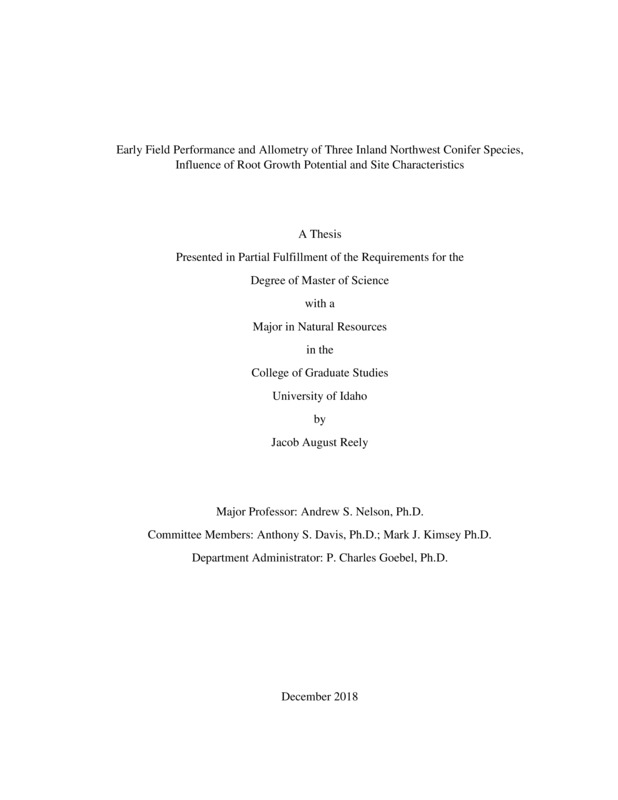Early Field Performance and Allometry of Three Inland Northwest Conifer Species, Influence of Root Growth Potential and Site Characteristics
Reely, Jacob August. (2018-12). Early Field Performance and Allometry of Three Inland Northwest Conifer Species, Influence of Root Growth Potential and Site Characteristics. Theses and Dissertations Collection, University of Idaho Library Digital Collections. https://www.lib.uidaho.edu/digital/etd/items/reely_idaho_0089n_11277.html
- Title:
- Early Field Performance and Allometry of Three Inland Northwest Conifer Species, Influence of Root Growth Potential and Site Characteristics
- Author:
- Reely, Jacob August
- ORCID:
- 0000-0002-1367-1175
- Date:
- 2018-12
- Keywords:
- Biomass Allocation Douglas-fir Early Field Performance grand fir Root Growth Potential western larch
- Program:
- Natural Resources
- Subject Category:
- Forestry
- Abstract:
-
Douglas-fir (Pseudotsuga menziesii var. glauca (Beissn.) Franco), grand fir (Abies grandis), and western larch (Larix occidentalis) containerized seedlings were evaluated for aeroponic root growth potential (RGP) and planted on sites with variable soil environments. The sites differed in aspect and soil moisture environment; north-aspect (wet), north-aspect (dry) and south-aspect. Height and diameter growth, as well as survival, were evaluated over the first two seasons after planting. During the first growing season seedlings were destructively sampled to create specific allometric models and evaluate how seedling biomass accumulation and partitioning patterns were influenced by RGP and soil conditions, and how this relates to the growth and survival of planted seedlings. Douglas-fir and western larch seedlings have significantly lower growth and survival on a south-aspect site, than on north-aspect sites but seem more influenced by site aspect differences than site soil moisture differences. All species accumulated greater biomass on sites without soil moisture limitations. Grand fir seedlings did not exhibit differences in two-year field performance across sites, but did exhibit different patterns of biomass allocation on the south-aspect site favoring shoot growth on the south-aspect site. The increased presence of competing vegetation resulted decreased growth and survival of planted seedlings after two growing seasons. Douglas-fir seedlings two-year survival increased with RGP on the wet north-aspect but decreased with RGP on the dry north-aspect site; grand fir seedlings with high RGP had greater survival on either north-aspect site. However, grand fir seedlings with high RGP the south-aspect site and western larch seedlings on the dry north-aspect site had lower survival than other seedlings. All species responded variably to within site differences in soil moisture and temperature, but there was not consistent response, and it seems that differences in growth and survival are more related to between site differences. RGP was a successful predictor of survival for the more stress-tolerant species on north-aspects, but Douglas-fir displayed a negative relationship between survival and RGP on the dry north-aspect site. Results will help managers better understand how RGP results relate to field performance and provide a mechanistic understanding of periodic changes in seedling morphology and how they relate to early growth and survival on common planting sites in the region.
- Description:
- masters, M.S., Natural Resources -- University of Idaho - College of Graduate Studies, 2018-12
- Major Professor:
- Nelson, Andrew S
- Committee:
- Davis, Anthony S; Kimsey, Mark J
- Defense Date:
- 2018-12
- Identifier:
- Reely_idaho_0089N_11277
- Type:
- Text
- Format Original:
- Format:
- application/pdf
- Rights:
- In Copyright - Educational Use Permitted. For more information, please contact University of Idaho Library Special Collections and Archives Department at libspec@uidaho.edu.
- Standardized Rights:
- http://rightsstatements.org/vocab/InC-EDU/1.0/

